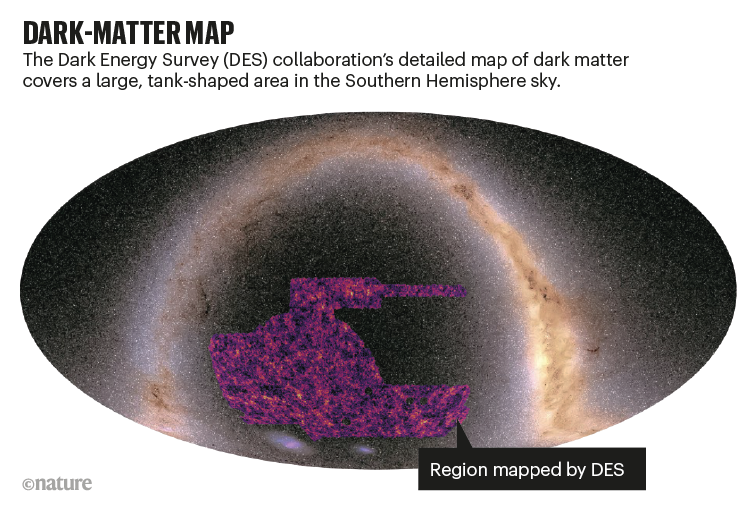A survey of the southern sky has reconstructed how mass is spread across space and time, in the biggest study of its kind. The data provide striking evidence that dark energy, the force that appears to be pushing the Universe to accelerate its expansion, has been constant throughout cosmic history.
The Dark Energy Survey (DES) collaboration revealed its results in an online briefing on 27 May and in several papers posted online.
The DES team observed the sky between 2013 and 2019 using a 570-megapixel camera at the Víctor M. Blanco telescope at the Cerro Tololo Inter-American Observatory in Chile. The survey covered one-quarter of the southern sky, and its exposures included 300 million galaxies.
“It’s an incredibly powerful data set,” comments Catherine Heymans, an astronomer at the University of Edinburgh, UK.
DARK MATTER MAP: oval shaped map of the sky with dark matter shown as a purple region
Credit: N. Jeffrey/Dark Energy Survey collaboration
The researchers grouped the galaxies by colour, to get a rough indication of each galaxy’s distance from our own: as the Universe expands, galaxies that are further away appear redder because their light waves have stretched out to longer wavelengths. That way, the team was able to add a third dimension to its map.
Looking further away also corresponds to looking to the past, so a 3D cosmic map provides a record of the Universe’s history. By tracking how galaxies spread out over time, cosmologists can then indirectly measure the forces at play. These include the gravitational pull of dark matter, the invisible stuff that constitutes some 80% of the Universe’s mass and dominates the formation of galaxies and clusters of galaxies.
Distorted galaxies to better reveal the presence of dark matter, the DES team analyzed the shapes of 100 million of the more distant galaxies. Because gravity curves space, the cosmologists were able to map large concentrations of dark matter in the closer regions of the Universe by seeing how their gravity squeezes the images of galaxies farther away, a phenomenon called weak gravitational lensing. “We observe our images of background galaxies to be slightly distorted,” explained DES member Alexandra Amon in an online briefing.
Mapping galaxies and dark matter in 3D also allows researchers to investigate dark energy, the force that’s pushing the Universe’s expansion to accelerate. The nature of this mysterious force is one of the major open problems in cosmology. All evidence so far has suggested that it is uniform throughout space and time, and DES has now provided the most stringent test of that hypothesis. When combined with data from other surveys, its 3D map has helped to cut the error margins down to about 3% — says DES member Michael Troxel of Duke University in Durham, North Carolina.
Ofer Lahav, a leading DES member at University College London, says that the result is a “triumph” for the standard model of cosmology, which assumes dark energy to be constant.
This will make it harder for cosmologists to support alternative models in which dark energy is a “tangible medium” that could wither away in the future.
Smoother than expected DES also found the Universe to be slightly smoother than expected — confirming findings that the collaboration first reported in 2017. “Lensing is persistently low compared to what the universe dictates,” said Amon, who is a cosmologist at the Kavli Institute for Particle Astrophysics and Cosmology in Menlo Park, California.
In addition to DES, two other major weak-lensing projects have reported a similar puzzling result — The Hyper Suprime-Cam survey, done by the National Astronomical Observatory of Japan’s Subaru Telescope in Mauna Kea, Hawaii; and the Kilo-Degree Survey at one of the European Southern Observatory’s telescopes in Chile, led by Heymans. All three surveys have found slightly less lensing — and therefore slightly less concentration of dark matter —than would be expected based on the prevailing model of cosmology.
When experimental uncertainties are factored in, the measurements are still broadly consistent with the standard model. Heymans says that it will be interesting to combine the results of the three weak-lensing surveys into one analysis to get a more precise measure of the possible discrepancy.
There is more to come from DES: the latest results were based on its first three years of data-taking, out of a total of six years. Starting next year, cosmology will take a major leap with two new observatories, the Vera Rubin Observatory in Chile and the European Space Agency’s Euclid space telescope. Both will conduct weak-lensing studies of unprecedented depth, and “they’re going to be doing this work on the full sky”, says Heymans.
Article via: Nature Journal



0 Comments